
Sebastian Schrader Disorder
Leipzig 6 Sep – 26 Oct 2019
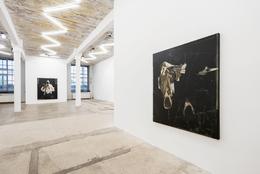
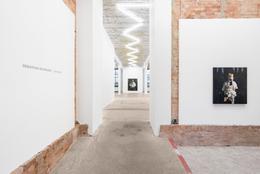
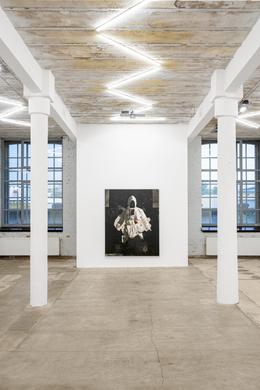
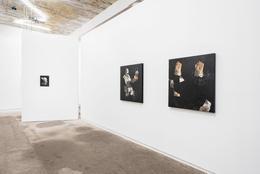
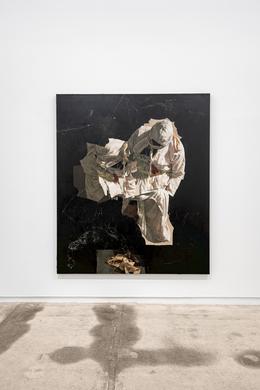
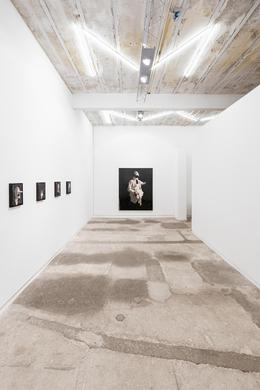
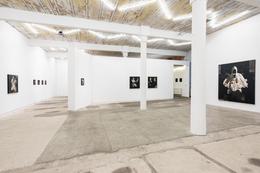
In 1979, Joy Division released the album "Unknown Pleasures," which included the song "Disorder". Its unmistakable melancholic sound and the desperate voice of the singer, Ian Curtis, who tragically committed suicide a few years later have contributed to making this band world-famous.
Fourty years after the release of "Disorder," Sebastian Schrader who was born one year before the release of the album (1978) titles his latest exhibition after the song.
How shall one make sense of this? We might ask ourselves if there is an analogy in the formal approach or perhaps, if this is just a pop-cultural reference. Is the reference misleading? The sinister aesthetics inherent to the piece seem to find its place in Schrader’s work. There are disturbances all over: scratch marks, torn images, scattered materials, at times discarded or rearranged. There are irregularities too: an arm hangs far too small beside its body or at least what is left of it. Nevertheless, the picture is just right, somehow balanced.
But the paintings are ultimately linked in that they are dark with figurative fragments. They look like islands from a dark sea. But darkness is not simply black, it is finely graded and forms the basis on which the paintings are set. The chiaroscuro contrast shapes the composition in ways that are reminiscent of Joy Division’s chopped-off guitar riffs. But of course, the historical roots of chiaroscuro in painting run deep. Schrader is well aware of the history of art and knows how to integrate it into his practice. The light direction of the baroque painters is just as close to him as the scribbles of a Cy Twombly. These emblematic abbreviations which dance cheerfully across the pictorial plane stop at nothing and for no one. Sometimes they give form and sometimes they remain ironically distanced or simply mysterious.
One might recognize a protective suit in the shapes painted. But it turns out to be an empty shell that has lost something important. What was worth protecting has evaporated or has been erased, irradicated. The body and with it the human being can only be supposed after a form. Where the body disappeared remains unclear. There are no certainties, no answers, only a painting.
But the love with which Schrader works out the materiality of the folds allows us to suppose things that are not visible. We see the sufferings of Christ, the intertwined garments that try out their own life. We project what we know and Schrader knows that. A shimmering light, a shining red and already he wanders away, our spirit. The painter lays a track, drawing from popular and so-called high cultures.
By freeing the suit from its body, Schrader seems to suggest that a transformation is possible. By leaving it empty, it becomes a sort of still life whose folds and many shades almost resemble flower blossoms. Beauty and shivers come together in a strange way.
Fourty years after the release of "Disorder," Sebastian Schrader who was born one year before the release of the album (1978) titles his latest exhibition after the song.
How shall one make sense of this? We might ask ourselves if there is an analogy in the formal approach or perhaps, if this is just a pop-cultural reference. Is the reference misleading? The sinister aesthetics inherent to the piece seem to find its place in Schrader’s work. There are disturbances all over: scratch marks, torn images, scattered materials, at times discarded or rearranged. There are irregularities too: an arm hangs far too small beside its body or at least what is left of it. Nevertheless, the picture is just right, somehow balanced.
But the paintings are ultimately linked in that they are dark with figurative fragments. They look like islands from a dark sea. But darkness is not simply black, it is finely graded and forms the basis on which the paintings are set. The chiaroscuro contrast shapes the composition in ways that are reminiscent of Joy Division’s chopped-off guitar riffs. But of course, the historical roots of chiaroscuro in painting run deep. Schrader is well aware of the history of art and knows how to integrate it into his practice. The light direction of the baroque painters is just as close to him as the scribbles of a Cy Twombly. These emblematic abbreviations which dance cheerfully across the pictorial plane stop at nothing and for no one. Sometimes they give form and sometimes they remain ironically distanced or simply mysterious.
One might recognize a protective suit in the shapes painted. But it turns out to be an empty shell that has lost something important. What was worth protecting has evaporated or has been erased, irradicated. The body and with it the human being can only be supposed after a form. Where the body disappeared remains unclear. There are no certainties, no answers, only a painting.
But the love with which Schrader works out the materiality of the folds allows us to suppose things that are not visible. We see the sufferings of Christ, the intertwined garments that try out their own life. We project what we know and Schrader knows that. A shimmering light, a shining red and already he wanders away, our spirit. The painter lays a track, drawing from popular and so-called high cultures.
By freeing the suit from its body, Schrader seems to suggest that a transformation is possible. By leaving it empty, it becomes a sort of still life whose folds and many shades almost resemble flower blossoms. Beauty and shivers come together in a strange way.
Artists